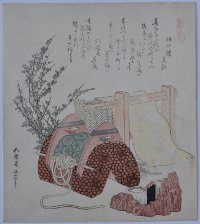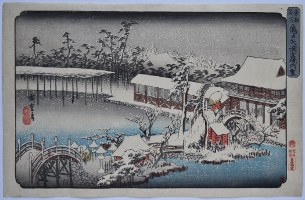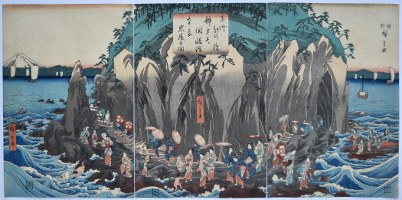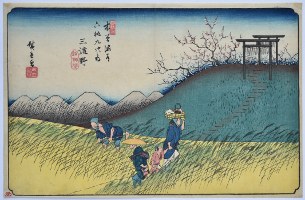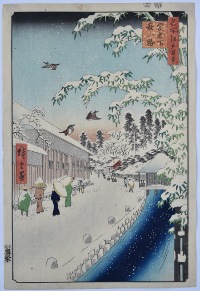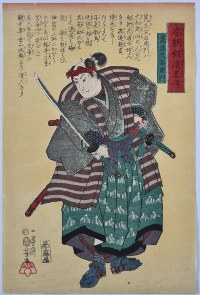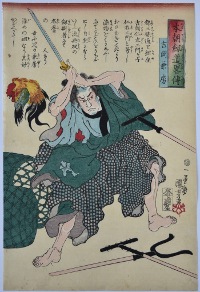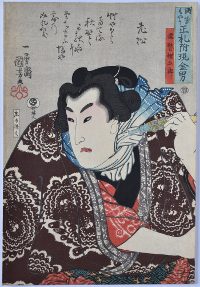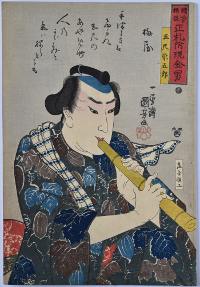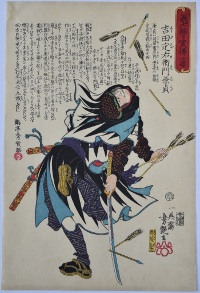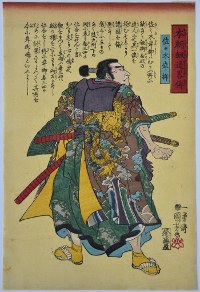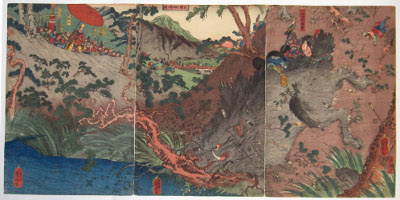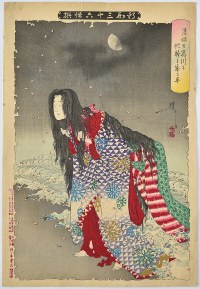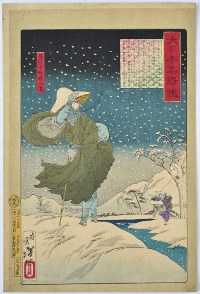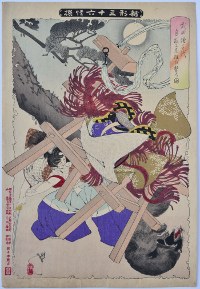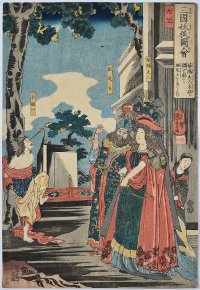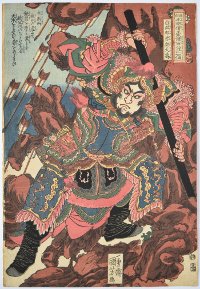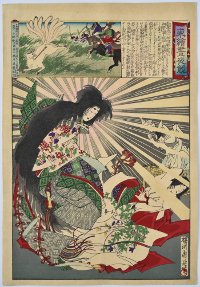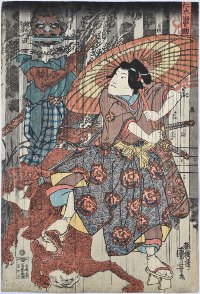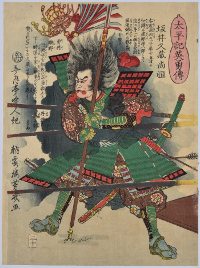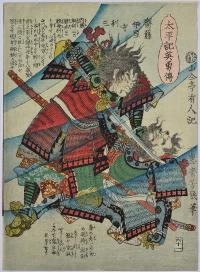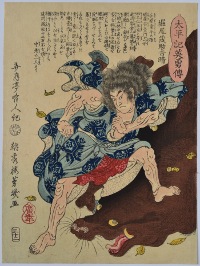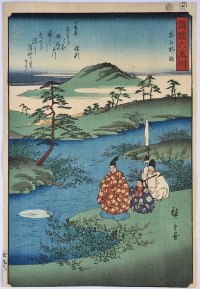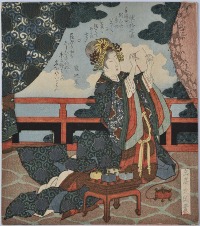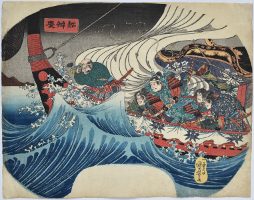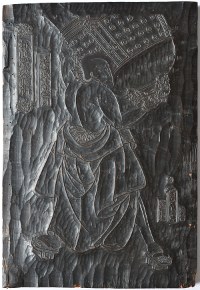/category/archive/page/14/
Katsushika HOKUSAI (1760-1849)
Click here to view image full size.
A surimono, Umazakushi, showing a saddle and cotton-gin from Watakuri uma, “A Series of Horses.” Issued for the Yomogawa club, 1822. Shows a horse’s saddle, a cotton-gin, basket of cotton floss and a branch of plum. A smoking set in the foreground. This set followed on from the success of the Shell surimono series issued in 1821. Twenty eight designs are known. The title (in a red gourd) top right is hand-stamped. Rare.
Fine impression with silver, gold and blind-printing. Fine colour. Minor soil, otherwise very good condition. Signed Fusenkyo Iitsu hitsu.
Status: Sold
Ichiryusai HIROSHIGE (1797-1858)
Click here to view image full size.
The compound of the Tenman Shrine at Kameido, Kameido Tenmangu keidai no yuki. The best design from a Toto meisho set of 21 prints published by Kikakudo (Sanoki) c 1832-5 and then extended to 55 in c. 1839-42. Also one of the best known places in Edo with the Drum Bridge, koi ponds and wisteria which flowered in the Fifth Month. The main shrine is dedicated to the memory of Sugawara no Michizane (Tenjin), the father of Japanese learning and built in 1662. Hiroshige shows the shrine in winter under falling snow.
Fine early impression with the red publisher’s seal in right margin (later editions having the black seal of Sanoki). These later editions have a black sky and a block defect appears at the edge of the pond centre left. Fine colour. Signed Hiroshige ga.
Status: Sold
Ichiryusai HIROSHIGE (1797-1858)
Click here to view image full size.
Soshu Enoshima Benzaiten kaicho mode Hongu Iwaya no zu, “Pilgrimage to the Cave Shrine of Benzaiten on Enoshima.” A triptych showing the back view of the island (the causeway being on the other side) with the Iwaya cave on the right. Groups of women from Edo schools of narrative chanting are seen with umbrellas (Benzaiten was a deity associated with music). The statue was displayed once every six years. Published by Sumiyoshi Masagoro, 1851.
Fine impression. Very good colour. Fine condition. Signed Hiroshige ga.
Status: Sold
Ichiryusai HIROSHIGE (1797-1858)
Click here to view image full size.
Midono from Kisokaido rokujukyutsugi no uchi , “Sixty-Nine Stations of the Kisokaido.” The set of seventy prints was published by Hoeido in 1835, but in 1837 Hiroshige took over and completed the series with the publisher Iseya Rihei (Kinjudo). The conjecture is that Hiroshige was the better known and more commercial artist, reinforced by the fact that Eisen’s name was removed from the designs already published. Hence only the first editions have his signature on those prints. Shows travellers in a field of pampas grass and a farm worker with a hoe to the left. On the hill above are torii gates leading to a Shinto shrine. The area here opens out after the narrow Kiso valley and is popular with walkers today. Provenance: Ex Grabhorn collection.
Fine impression of the earliest state with bokashi on the brow of the hill. Fine colour. Slight centre fold, otherwise very good condition. Signed Hiroshige ga.
Status: Sold
Ichiryusai HIROSHIGE (1797-1858)
Click here to view image full size.
A snow scene: Atago shita yabukoji, “Bamboo Lane Below Atago Hill” from Edo meisho hyakkei, “The Hundred Famous Views of Edo”. Published by Uoya Eikichi between Ansei 3 and 5 (1856-58). This design dated Dragon 12 (1856). The large building on the left housed the daimyo’s servants and retainers.
Very good impression and colour. Small backed wormhole in top margin, otherwise very good condition. Signed Hiroshige ga.
Status: Sold
Utagawa KUNIYOSHI (1797-1861)
Click here to view image full size.
Araki Matayemon standing, examining his sword from Honcho kendo ryaku den, “Abridged Stories of Our Country’s Swordsmanship.” The set published by Kadzusaya Iwazo in c 1845-6.
Extremely fine impression, colour and condition. Solid yellow ground. Signed Ichiyusai Kuniyoshi ga.
Status: Sold
Utagawa KUNIYOSHI (1797-1861)
Click here to view image full size.
Yoshioka Kanefusa defending himself in an attack by police from Honcho kendo ryaku den, “Abridged Stories of Our Country’s Swordsmanship.” The set published by Kadzusaya Iwazo in c 1845-6.
Extremely fine impression, colour and condition. Solid yellow ground. Signed Ichiyusai Kuniyoshi ga.
Status: Sold
Utagawa KUNIYOSHI (1797-1861)
Click here to view image full size.
A bust portrait of the sumo wrestler Nuregami Chogoro holding a pipe from the series Kuniyoshi moyo shofuda tsuketari genkin otoko, “ Men of Ready Money with True Labels Attached, Kuniyoshi Fashion.” The title derived from a contemporary kabuki play Shofuda tsuki kongen kusazuri. Poem above by Rosho. Robinson S40.5. Published by Ibaya Kyubei, 1845.
Fine impression and colour. Slight trimming and retains original album backing, otherwise fine condition. Signed Ichiyusai Kuniyoshi ga.
Status: Sold
Utagawa KUNIYOSHI (1797-1861)
Click here to view image full size.
A bust portrait of Goshaku Somegoro playing a shakuhachi from the series Kuniyoshi moyo shofuda tsuketari genkin otoko, “ Men of Ready Money with True Labels Attached, Kuniyoshi Fashion.” The title derived from a contemporary kabuki play Shofuda tsuki kongen kusazuri. Poem above by Umeya. Robinson S40.3. Published by Ibaya Kyubei, 1845.
Fine impression and colour. Slight trimming and retains original album backing, otherwise fine condition. Signed Ichiyusai Kuniyoshi ga.
Status: Sold
Ichieisai YOSHITSUYA (1822-1866)
Click here to view image full size.
Yoshida Sadaemon Kanesada slicing arrows in half with his sword from a set Gishi Meimei jitsu den, “Biographies of Loyal Followers [aka The 47 Ronin].” The series published by Tsujiokaya Bunsuke, 1860.
Extremely fine impression, colour and condition. Signed Ichieisai Yoshitsuya ga.
Status: Sold
Utagawa KUNIYOSHI (1797-1861)
Click here to view image full size.
Sasaki Ganryu standing, in profile, with clenched fist, from Honcho kendo ryaku den, “Abridged Stories of Our Country’s Swordsmanship.” The set published by Kadzusaya Iwazo in c 1845-6.
Extremely fine impression, colour and condition. Solid yellow ground. Signed Ichiyusai Kuniyoshi ga.
Status: Sold
Utagawa KUNIYOSHI (1798 – 1861)
Click here to view image full size.
Tadatsune killing the monstrous wild boar watched by Yoritomo and his entourage. Published c 1842-3. Robinson T99.
Fine impression and colour. Minor trimming, otherwise very good condition. Signed Ichiyusai Kuniyoshi ga.
Status: Sold
Taiso YOSHITOSHI (1839-1892)
Click here to view image full size.
Kiyohime assumes a serpent form at Hidaka river as she continues her pursuit of the monk Anchin. From the set Shinkei sanjurokkaisen, “New Forms of Thirty-Six Ghosts.” The set published by Sasaki Toyokichi, 1889 and 1890.
Extremely fine impression of the first edition with three-colour cartouche. Fine colour and condition. Signed Yoshitoshi.
Status: Sold
Taiso YOSHITOSHI (1839-1892)
Click here to view image full size.
A design showing Hojo Tokiyori in a snowy landscape from the set Dai Nippon meisho kagami, “Mirror of Famous Commanders of Great Japan.” He was Regent during the Kamakura period (1185-1333) but withdrew to the temple of Saimyoji and subsequently travelled around the country incognito to familiarize himself with the conditions of the populace. Published by Funazu Chujiro, 1878.
Fine impression with extensive burnishing. Fine colour. Light backing, otherwise very good condition. Signed Oju Yoshitoshi hitsu.
Status: Sold
Taiso YOSHITOSHI (1839-1892)
Click here to view image full size.
Takeda Katsuchiyo in his boyhood killing an old badger which had transformed itself into a wooden saddle-horse. From the set Shinkei sanjurokkaisen, “New Forms of Thirty-Six Ghosts.” The set published by Sasaki Toyokichi, 1889 and 1890.
Very fine impression of the first edition with three-colour cartouche. Fine colour. Very good condition. Signed Yoshitoshi.
Status: Sold
Utagawa KUNIYOSHI (1797-1861)
Click here to view image full size.
India from Sangoku yoko zue, “The Magic Fox of the Three Countries [China, India, Japan].” A set with strong western elements. Here showing Kwayo-fujin (the fox) having shot a St. Sebastian-like figure in the eye watched by King Hansoku. Both attired in exotic and archaic western garments and head pieces. Also western influences in the sky, trees and architecture. The set published by Iseya Chusuke and Echizenya Hachiyemon, c 1849-50. Unidentified collector’s seal bottom left. Rare.
Fine impression with strong woodgrain. Very good colour and condition. Signed Ichiyusai Kuniyoshi ga.
Status: Sold
Utagawa KUNIYOSHI (1797-1861)
Click here to view image full size.
The warrior Hakumenrokun Teitenju in full armour levering a mass of rock with an iron bar. A design from the set Tsuzoku Suikoden goketsu hyaku-hachi-nin no hitori, “The Hundred and Eight Heroes of the Popular Suikoden, One by One.” Based on the Chinese novel Shui Hu Zhuan, attributed to Shi Nai’an, which tells of a band of 108 brigands who operated from Liangshan Marsh. Published by Kagaya Kichiyemon, 1827-30. Robinson S2.20. There is another version of this design with yellow rocks and the sky a solid blue.
Fine impression, colour and condition. Full size (unusual as these prints are overlarge obans and often trimmed). Signed Ichiyusai Kuniyoshi ga.
Status: Sold
Toyohara CHIKANOBU (1838-1912)
Click here to view image full size.
An apparition of a nine-tailed fox. These foxes could turn themselves into beautiful women when a hundred years old. From a set of 50 prints: Azuma nishiki chuya karabe, “Eastern Brocades, Day and Night, Compared.” Published by Kobayashi Tetsujiro, 1886.
Very fine impression. Fine colour and condition. Signed Yoshu Chikanobu hitsu.
Status: Sold
Utagawa KUNIYOSHI (1798-1861)
Click here to view image full size.
An early design without series title showing Nikki Gennosuke in pouring rain fending off wild wolves while suddenly observing the apparition of a dead man behind him. Published by Tsuta-ya Kichizo, c 1840. Robinson S1e.2. A fine and rare design.
Very good impression and colour. Slight trimming, otherwise very good condition. Signed Ch-o-ro Kuniyoshi ga.
Status: Sold
Utagawa YOSHIIKU ( 1833-1904 )
Click here to view image full size.
No. 30, Sakai Kuzo Hisatsune surviving gunshot from a large chuban series Taiheiki eiyuden “ Biographies of the Heroes of the Taiheiki.” A fictional history written in the late 14th century. The set published by Hirooka Kosuke, 1/1867. One of the four best designs from the set.
Fine impression, colour and condition. Signed Chokaro Yoshiiku ga.
Status: Sold
Utagawa YOSHIIKU ( 1833-1904 )
Click here to view image full size.
No. 61, Saito Izu-no-kami Toshimitsu fighting an adversary under water from a large chuban series Taiheiki eiyuden “Biographies of the Heroes of the Taiheiki. “ A fictional history written in the late 14th century. The set published by Hirooka Kosuke, 1/1867. One of the four best designs from the set.
Fine impression, colour and condition. Signed Ikkeisai Yoshiiku hitsu.
Status: Sold
Utagawa YOSHIIKU ( 1833-1904 )
Click here to view image full size.
No. 32, Horio Mosuke Yoshiharu fighting a large boar from a large chuban series Taiheiki eiyuden “ Biographies of the Heroes of the Taiheiki. “ A fictional history written in the late 14th century. The set published by Hirooka Kosuke, 1/1867. One of the four best designs from the set.
Fine impression, colour and condition. Signed Chokaro Yoshiiku ga.
Status: Sold
Takahashi CHIHARU (1777-1859)
Sold
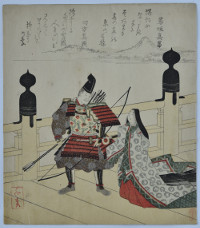
Click here to view image full size.
A surimono in Yamato-e style showing Otohime and Tawara Toda on the long bridge at Seta. There are different versions of this popular legend. One has it that Otohime, the Dragon Princess, had an enemy in the form of a giant centipede that lived and poisoned Lake Biwa. It had also killed two of her sons. She begs Tawara Toda Hidesato, a famed archer, to kill it. This he does and she rewards him in the Dragon Palace with silk, a sword and armour, a temple bell, and a bag of rice. The silk and rice are to last forever, however much is used. Hence his name Tawara Toda, “Rice-bag Toda.” Probably issued for Dragon year 1832.
Fine impression, very good colour and condition. Signed Chiharu.
Status: Sold
Ichiryusai HIROSHIGE ( 1797-1858 )
Click here to view image full size.
Noji Tama River in Omi Province with a poem by Minamoto no Toshiyori from the series of six prints Shokoku Mutamagawa , “Six Jewel Rivers in the Provinces.” Shows a nobleman and attendants admiring the moon’s reflection. The set published by Maruya Kyushiro 11/1857.
Very fine impression. Fine colour. Trimmed on black border at bottom, otherwise fine condition. Signed Hiroshige ga.
Status: Sold
Ryuryukyo SHINSAI (Active c 1799-1823)
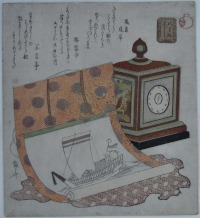
Click here to view image full size.
A surimono showing a scroll with a painting of a Takarabune ship and an enameled Persian clock (with Arabic numerals). Norizome, “Maiden Voyage [of the New Year].” The Takarabune, “Treasure Ship” is associated with the new year and carries the Seven Lucky Gods (Shichifukujin) with their treasures. Shinsai was a pupil of Hokusai and is best known for his surimono prints. Issued in 1822 by the Taiko-gawa, “Drum Poetry Group” with their emblem top right. Three poems by Shikishishima Michikusa; Ume no Sugatame; Fugentai. Another (trimmed) impression is in the MET, JP2116.
Fine impression. Very good colour. Minor soil, otherwise very good condition. Signed Shinsai.
Status: Sold
Katsushika HOKUSAI (1760-1849)
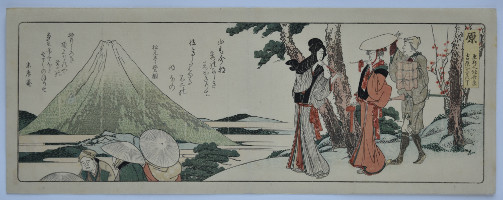
Click here to view image full size.
A surimono, Hara, from an untitled Tokaido set, generally called the Surimono Tokaido. Published in 1804 for a kyoka club. There are 59 prints in the set; 8 being in this horizontal tanzaku format, the rest being koban size. This is the very rare first edition with the kyoka poems. In the second edition, also in 1804, the poems are left out. There is also a third edition in 1805 and a fourth in the 1840s where these tanzaku designs were replaced by koban prints designed by Hokusai’s pupil Yanagawa Shigenobu. Shows travellers admiring Fuji.
Very fine impression. Fine colour and condition. Signed Gakyojin Hokusai ga.
Status: Sold
Utagawa KUNIYOSHI (1797-1861)
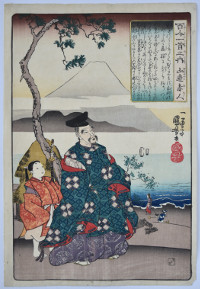
Click here to view image full size.
A design from Hyaku-nin isshu, “The Hundred Poets.” Shows the poet Yamabe no Akahito (fl. 724-736) with a page walking beside the bay of Tago, with Fuji beyond. He is noted as one of the Thirty-six Poetry Immortals. Published by Yebi-Ne, 1840-2. A set with some fine compositions.
Very fine impression, colour and condition. Signed Ichiyusai Kuniyoshi ga.
Status: Sold
Utagawa YOSHITSUYA (1822-1866)
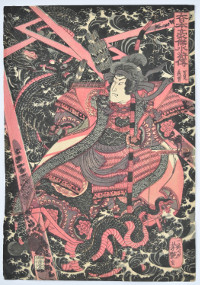
Click here to view image full size.
One of the Eight Dog Heroes, Satomi Yoshizane, seated surrounded by a dragon, thunderbolts and waves. From a set Dai Nippon goketsu Suikoden, “Great Japanese Heroes of the Popular Suikoden.” The set (?) published by Shimizuya Tsuejiro, c. 1843-5.
Fine impression, colour and condition. Signed Ichieisai Yoshitsuya ga.
Status: Sold
Utagawa HIROSHIGE (1797-1858)
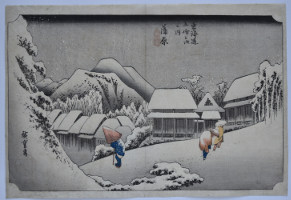
Click here to view image full size.
Kambara, yoru no yuki, “Night Snow at Kambara” from Tokaido gojusan tsugi no uchi, “Fifty-three Stations of the Tokaido Road.” The set published by Hoeido (Takenouchi Magohachi)/Senkakudo, c. 1833-4. One of Hiroshige’s most celebrated designs, discussed and illustrated extensively. This is the very rare first edition: The sky is graded down from the top and the last figure on the right has the uncleared wood evident on the legs. This mistake was soon rectified but in doing so the block cutter made a small break above the knee. Probably the earliest state of the first edition has a blue tint to the gradation on the distant hills: See the Honolulu Academy of Arts impression, 15.927. Kambara owes a lot to Hiroshige’s imagination as it doesn’t resemble any place near there. Also, Kambara has little snow, yet it remains one of Hiroshige’s most iconic images.
Fine impression of the first edition with subtle gradation on the roofs of the houses and elsewhere. Seals a little faded, otherwise very good colour. Slight centre fold, otherwise very good condition. Signed Hiroshige ga.
Status: Sold
Utagawa HIROSHIGE (1797-1858)
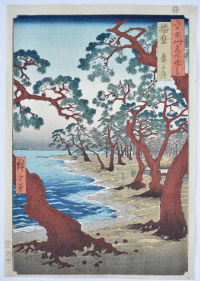
Click here to view image full size.
Harima Maiko no hama, “Maiko Beach Harima Province” from Rokujuyoshu meisho zue, “Famous Views of the Sixty-odd Provinces.” Shows the beach with the famous pine forest stretching down to the water. Published by Koshihei, 1853-6, this being 1853.
Fine impression of the first edition. Slight fading, otherwise very good colour. Fine condition. Signed Hiroshige ga.
Status: Sold
Utagawa HIROSHIGE (1797-1858)
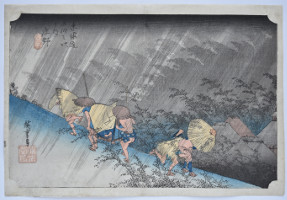
Click here to view image full size.
Shono, haku-u, “Sudden Shower at Shono” from Tokaido gojusan tsugi no uchi, “Fifty-three Stations of the Tokaido Road.” The set published by Hoeido (Takenouchi Magohachi)/Senkakudo, c. 1833-4. Together with Kambara, one of Hiroshige’s most celebrated designs, discussed and illustrated extensively. This is the very rare first edition: The waves of bamboo beautifully graded and strong woodgrain evident on the house roofs bottom right. See Sebastian Izzard, Hiroshige, The Ukiyo-e Society of America, 1983, nos. 17a-e for illustrations and a description of the various states. Although the area had thick groves of bamboo growing along the Suzuka River, there was nowhere that exactly matches the design.
Fine impression of the first edition with subtle gradation. Seals and green a little faded, otherwise very good colour. Slight centre fold, otherwise very good condition. Signed Hiroshige ga.
Status: Sold
Utagawa HIROSHIGE (1797-1858)
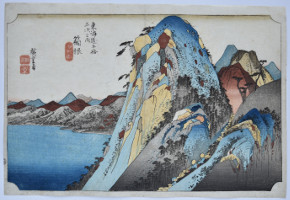
Click here to view image full size.
Hakone, kosui, “Hakone, the Lake” from Tokaido gojusan tsugi no uchi, “Fifty-three Stations of the Tokaido Road.” The set published by Hoeido (Takenouchi Magohachi)/Senkakudo, c. 1833-4. A line of travellers – presumably the deputation of the Edo Shogunate going to Kyoto – making its way down a precipitous path on the right in this mountainous region. This is the very rare first edition: An extremely difficult design to find in early impression as the jigsaw of colours on the mountains need to be perfectly keyed to work.
Fine impression. The red a little faded, otherwise very good colour. Slight centre fold, otherwise very good condition. Signed Hiroshige ga.
Status: Sold
Utagawa HIROSHIGE (1797-1858)
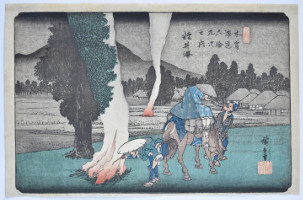
Click here to view image full size.
Station Karuizawa from Kisokaido rokujukyo tsugi no uchi, the “Sixty-nine Stations of the Kiso Kaido.” A night scene after the autumn harvest and the stubble is being burned. In the background the village and Mt Asama in the distance. A traveller stops to get his pipe lit by another traveller illuminated by the light cast from his lantern. Another traveller stoops to light his pipe from one of the bonfires. Published by Hoeido (Takenouchi Magohachi)/Kinjudo (Iseya Rihei), c. 1838. The lantern is inscribed Iseri (for Iseya Rihei) and their mon is partially seen on the saddlecloth of the horse. On later editions this seal was removed. The first edition of this design has a Takenouchi seal to the left of the inscription top centre.
Fine impression. Very good colour and condition. Signed Hiroshige ga.
Status: Sold
Utagawa HIROSHIGE (1797-1858)
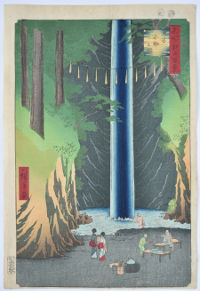
Click here to view image full size.
Oji, Fudo no taki, “Fudo Waterfall, Oji” from Meisho Edo hyakkei, “One Hundred Famous Views of Edo.” The set published by Uoya Eikichi between 1856 and 1859 (this being 1857). Waterfalls were a pleasant way of getting relief from the summer heat. Japan has many hundreds of waterfalls but a considerable number are in remote areas. The government has compiled a list of 100. This is the rare first edition with strong wood-grain and mica applied to the waterfall. Provenance: Purchased from me in 1989.
Very fine impression. Fine colour and condition. Signed Hiroshige ga.
Status: Sold
Utagawa HIROSHIGE (1797-1858)
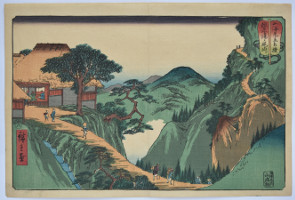
Click here to view image full size.
Echizen Yunoo toge, “Yunoo Pass in Echizen Province” from a set of twenty prints Sankai mitate zumo, “Wrestling Matches Between Mountains and Sea.” Ten prints showing mountain scenes and ten sea scenes (actually harbours). Published by Yamadaya Shojiro, 1858. The title is in a wrestling umpire’s fan. This is the first edition with variegated colour in this fan. The second edition has the fan printed in red only (see BM impression, 1915, 0823,0.152.7).
Fine impression and colour. Slight centre fold, otherwise fine condition. Signed Hiroshige ga.
Status: Sold
Utagawa HIROSHIGE (1797-1858)
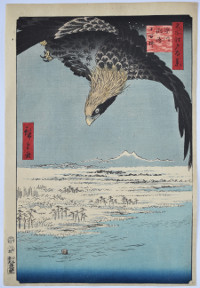
Click here to view image full size.
Fukagawa, Suzaki, juman-tsubo, “The One Hundred Thousand Tsubo Plain, Suzaki, Fukagawa” from Meisho Edo hyakkei, “One Hundred Famous Views of Edo.” The set published by Uoya Eikichi between 1856 and 1859 (this being 1857). An eagle hovers over the snowy coastal plain, Mt Tsukuba and the Chiba mountains in the distance.
Very good impression, colour and condition. Signed Hiroshige ga.
Status: Sold
Toyohara KUNICHIKA (1835-1900)
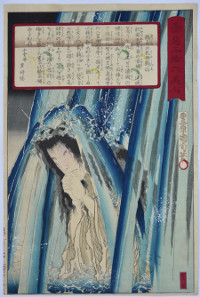
Click here to view image full size.
Uba Shizu of Nabeshima praying under a waterfall from a set Zen’aku sanuroku bijin, “Thirty-six Good and Evil Beauties.” The set published by Sawamuraya Seikichi, 1876.
Very fine impression and colour with splashed gofun. Very good condition. Signed Toyohara Kunichika hitsu.
Status: Sold
Yashima GAKUTEI (active 1815-1852)
Click here to view image full size.
A surimono showing a Chinese lady threading a needle on a balcony. First issued in Osaka for the Drum Group, c 1824. This is the excessively rare first edition with the blue sky and clouds; verses by two Osaka poets, and the coloured thread is connected to the spool on the floor. Another genuine impression is in the Metropolitan Museum of Art, accession number JP2090. In the second state the verses are replaced by Edo poets. In the third state the blue sky is replaced with a gold ground and there is a hand-stamped title. There are clever copies of this surimono produced in the 1890s. This is possibly the only other genuine impression of the first edition extant.
Fine impression and colour with areas of gold. Fine condition. Signed Gakutei Sadaoka hitsu. Ex Hayashi collection, seal bottom right.
Status: Sold
Utagawa KUNIYOSHI (1798-1861)
Click here to view image full size.
An uncut fan print, Funa Benkei, “Benkei in a Boat.” Shows Yoshitsune’s boat fleeing from Kyoto and his brother Minamoto no Yorimoto. The boat encounters the ghosts of the slain Heike clan who rise from the waves. However, Benkei, by praying to the gods, is able to avert disaster and calm the storm. Benkei is seen with his rosary at the prow of the boat. Of the utmost rarity. Seemingly only two other impressions known: One illustrated in Kuniyoshi, Nikkei Inc, 2011, no. 47 and the other in Kuniyoshi, Juzo Suzuki, Heibonsha Ltd, no. 102. (The V. & A. copy.) These impressions also illustrated elsewhere. Published c. 1840.
Fine impression and colour. Restored binding holes at left edge and minimal soil at corners. Probably the best example extant. Signed Ichiyusai Kuniyoshi ga.
Status: Sold
Utagawa KUNISADA II (1823-1880)
Click here to view image full size.
An original double-sided wood-block showing on one side the busts of three wrestlers with a title cartouche Ozumo tozai kurabe, “A Sumo Contest Between East and West.” On the other side is a sumi key-block for a set Kurikara kongo den, “Legends of the Dragon Sword and the Thunderbolt of Absolute Truth.” Shows Benkei Taikumon heaving (presumably) the large bell of Mii Temple. The set was published in 1863. Interestingly, the heads on the sumo side have been altered by plugging-in new wrestlers.
Generally in good condition with the usual edge damage. Sold “as is.” Rare.
Status: Sold
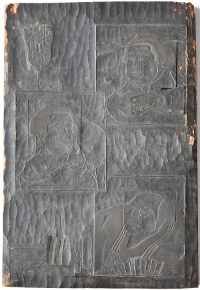
Click here to view image full size.
